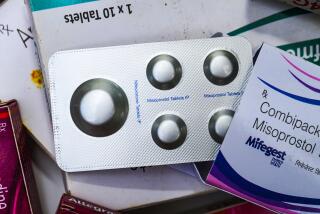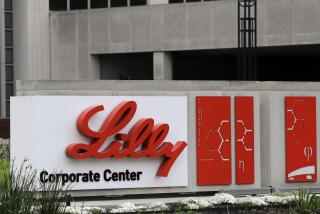Firms Battle Bills to Restrict Profits on Rare-Disease Drugs
- Share via
WASHINGTON — It was a law with a curious name and grand intentions: to provide financial incentives that would motivate drug companies to develop treatments for an estimated 5,000 rare diseases.
Without such incentives, the reasoning went, drug companies would be unlikely to do the research and production on their own. Some of the diseases afflicted only a few hundred people nationwide, meaning it would have cost the companies more to produce the drugs than they could hope to earn from sales.
The solution was the Orphan Drug Act, approved by Congress in 1983.
While it has been enormously successful by any measure--spurring the production of at least five dozen important drugs--lawmakers failed to foresee some complications. As a result, amendments are under consideration.
BACKGROUND: A key provision of the law grants companies seven years of exclusive marketing rights for “orphan drugs” they produce.
That provision was a strong incentive. But critics say that because companies are unfettered by competition, they have been free to price the drugs they develop as high as they pleased. In some cases, that has meant enormous profits. And some drugs were priced beyond the reach of the patients they were intended to help.
Lawmakers also did not anticipate that the number of patients needing a particular drug might burgeon, or that new or expanded uses for an orphan drug might be found--as has happened in about a half-dozen cases.
Controversy has increased now that some of the drugs, once needed by only a handful of people, are in greater demand because of the AIDS epidemic.
The most dramatic example of this legislative Catch-22 may be the case of pentamidine, a drug originally administered intravenously to an estimated 300 people in this country suffering from pneumocystis carinii pneumonia, a life-threatening infection that often strikes individuals whose immune systems are compromised.
The drug received orphan status, entitling it to the government-sanctioned incentives, when the population at risk was confined mostly to transplant recipients taking immune-suppressing drugs.
Since the AIDS epidemic, however, thousands of individuals have needed the drug both to treat pneumocystis and--in an aerosol version--to prevent it. The drug’s cost soared.
Other examples of high-priced orphan drugs include Ceredase, developed by Genzyme Corp., a drug for Gaucher’s disease that costs an average of $350,000 a year per patient, and human growth hormone, developed by Genentech Inc., which has had a cumulative sales total of $580 million.
Congressional legislation is pending that would set a $200-million sales trigger on the cumulative sales of each orphan drug--meaning that once sales hit that level, the drug will lose its exclusivity. Also, once the market for the drug reaches 200,000 people, it would no longer remain an orphan. The bill is sponsored by Sens. Nancy Landon Kassebaum (R-Kan.) and Howard M. Metzenbaum (D-Ohio) in the Senate, and Rep. Gerry E. Studds (D-Mass.) in the House.
During the last session of Congress, a weaker version was passed unanimously by both houses, but vetoed by President Bush. The earlier bill provided for a population level of 200,000 but did not contain a sales cap. Also, it would have allowed more than one company to share profits of a drug under certain conditions.
OUTLOOK: The current bill is considered much stronger but its prospects for passage are much tougher.
It is opposed by the pharmaceutical industry, which views it as the beginning of price controls. It may face a presidential veto.
“We must not tinker with this very successful act,” said Food and Drug Administration Commissioner David A. Kessler at a recent Senate hearing on the bill.
But Metzenbaum said the legislation will not damage the overall impact of the law.
“A few makers are abusing the act,” he said. “They are taking advantage of their monopoly to charge outrageous prices. . . . Most drugs have no expectation of achieving $200 million. That’s a pretty high threshold.”
More to Read
Sign up for Essential California
The most important California stories and recommendations in your inbox every morning.
You may occasionally receive promotional content from the Los Angeles Times.













